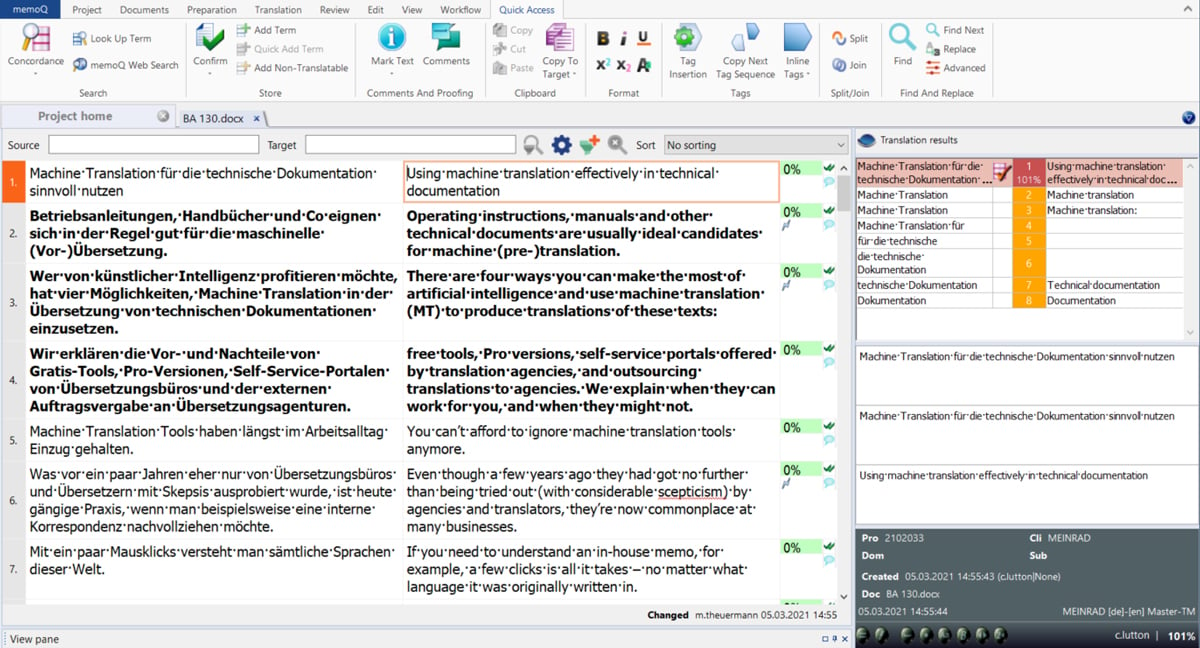
In the 21st century, professional translation services are unthinkable without the latest technology and software. A key element of this is CAT tools, which offer a wide range of useful features for clients, project managers and translators. MEINRAD explains what CAT tools are, how they work, and how modern translation agencies use them.
Professional translators have long since moved on from translating in the source file itself – that now only happens in exceptional circumstances. Instead, agencies and translators produce their translations in software programs known as CAT tools.
What are CAT tools, and what are they used for?
CAT is an acronym which stands for Computer-Assisted Translation. But it’s not to be confused with machine translation! A CAT tool is a program in which professional translators produce their translations. The software offers a range of helpful features for translators, such as integration of term bases and translation memories and the ability to work with machine translation plug-ins, and CAT tools are also very useful for project managers overseeing translation projects.
What can CAT tools do?
CAT tools combine various features, including term bases and computer-assisted quality assurance, but the heart of any CAT tool is the translation memories. These follow the “Translated once, stored for ever” principle: as soon as a piece of text is translated, it is added to the translation memory for that client. A separate translation memory, containing the individual sentences and their translation, is created for each language pair, and the translation memory can be used as a resource for all future translations. Before the translation itself begins, the computer analyses the text to identify any sentences in the new document which may have been translated before and inserts the translation in the right place. That means only the new text has to be translated, and clients save considerable amounts of money. CAT tools also allow translation agencies to manage translations and assign projects to their freelance translators via a server, so that all the translators have to do is check out the project from the server and start translating.
How are translations produced in a CAT tool?
When a translation agency receives a text, they import it into the CAT tool. High-quality CAT tools can handle a wide range of file formats, but it’s important that the text to be translated is editable, otherwise the CAT tool won’t be able to “extract” it. When the project manager imports the documents to be translated, the CAT tool “splits” the text into individual segments. Segments can contain a whole sentence or just individual words or phrases, and they usually end at punctuation such as full stops, question marks and colons. The result is clear segmentation of the text, as shown below.

© MEINRAD View of a translation project in a CAT tool
The tool then analyses the content of the file, compares it with the translation memory, and within a few seconds – or minutes if larger files are involved – the project manager knows how many (new) words need to be translated. This analysis also allows the costs for the project to be calculated.
The translator sees a two-column table view in the CAT tool’s translation editor, with the source text split into segments on the left and the space to enter the translation in the target language on the right. When the translator is working on a particular sentence, similar sentences and fragments from the translation memory are displayed in the top right panel, and they can then decide to use what’s suggested or to translate the sentence afresh. This improves consistency both within a document and across all translated documents. Also shown in the top right panel to help the translator are specialist terms from the term base.
Once the translation is complete and the quality check has been carried out, the file is exported from the CAT tool and saved again in its original format.
What are the benefits of CAT tools?
There are numerous reasons why clients benefit from using a CAT tool rather than simply translating texts in the program used to produce them, including:
- Translation memories that save you money
- Exact analysis of repeated words/sentences to avoid paying twice for the same translations
- Better translations thanks to term bases and quality assurance checks
- Higher translator productivity, meaning shorter delivery times
- Use of consistent terminology
- Use of consistent language (reuse of existing translations)
- Quick, accurate file analysis and automatic calculation of costs
- Support for a wide range of file formats – and the translated file looks exactly like the original
- Interfaces for seamless integration with authoring systems (with the potential for automated translations)
What types of CAT tools are there?
With all these key benefits, CAT tools have become nothing less than indispensable for translation service providers. There are two main types of CAT tools – server-based and cloud-based – and a wide range of programs, such as SDL Trados Studio, memoQ, Wordfast, Déjà Vu, Across, OmegaT and many more. They differ slightly from each other in the details of how they work, but their essential features are the same, and each translation agency has its favourite(s). Companies sometimes produce their own translations in-house using a CAT tool, in which case it’s advisable to establish a common platform with their language service provider so that both parties can benefit as much as possible from the translation memories and term bases.
Other posts which may interest you:

Why honesty is the best policy when it comes to machine translation |

Signed, sealed, delivered: agreements with translation agencies |

The smart way to compare quotes from language service providers |
Main image: © Adobe Stock

